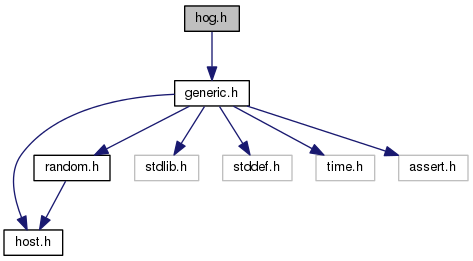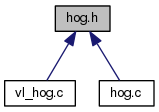Histogram of Oriented Gradients (Histogram of Oriented Gradients (HOG) features) More...
#include "generic.h"

Go to the source code of this file.
Classes | |
| struct | VlHog_ |
Typedefs | |
| typedef struct VlHog_ | VlHog |
| typedef enum VlHogVariant_ | VlHogVariant |
Enumerations | |
| enum | VlHogVariant_ { VlHogVariantDalalTriggs, VlHogVariantUoctti } |
Functions | |
| VL_EXPORT void | vl_hog_delete (VlHog *self) |
| Delete a HOG object. | |
| VL_EXPORT void | vl_hog_extract (VlHog *self, float *features) |
| Extract HOG features. | |
| VL_EXPORT vl_size | vl_hog_get_dimension (VlHog const *self) |
| Get the dimension of the HOG features. | |
| VL_EXPORT vl_size | vl_hog_get_glyph_size (VlHog const *self) |
| Get HOG glyph size. | |
| VL_EXPORT vl_size | vl_hog_get_height (VlHog *self) |
| Get the height of the HOG cell array. | |
| VL_EXPORT vl_index const * | vl_hog_get_permutation (VlHog const *self) |
| Get HOG left-right flip permutation. | |
| VL_EXPORT vl_bool | vl_hog_get_use_bilinear_orientation_assignments (VlHog const *self) |
| Tell whether assignments use bilinear interpolation or not. | |
| VL_EXPORT vl_size | vl_hog_get_width (VlHog *self) |
| Get the width of the HOG cell array. | |
| VL_EXPORT VlHog * | vl_hog_new (VlHogVariant variant, vl_size numOrientations, vl_bool transposed) |
| Create a new HOG object. | |
| VL_EXPORT void | vl_hog_process (VlHog *self, float *features, float const *image, vl_size width, vl_size height, vl_size numChannels, vl_size cellSize) |
| VL_EXPORT void | vl_hog_put_image (VlHog *self, float const *image, vl_size width, vl_size height, vl_size numChannels, vl_size cellSize) |
| Process features starting from an image. | |
| VL_EXPORT void | vl_hog_put_polar_field (VlHog *self, float const *modulus, float const *angle, vl_bool directed, vl_size width, vl_size height, vl_size cellSize) |
| Process features starting from a field in polar notation. | |
| VL_EXPORT void | vl_hog_render (VlHog const *self, float *image, float const *features, vl_size width, vl_size height) |
| Render a HOG descriptor to a glyph image. | |
| VL_EXPORT void | vl_hog_set_use_bilinear_orientation_assignments (VlHog *self, vl_bool x) |
| Turn bilinear interpolation of assignments on or off. | |
Detailed Description
Histogram of Oriented Gradients (Histogram of Oriented Gradients (HOG) features)
Definition in file hog.h.
Typedef Documentation
| typedef enum VlHogVariant_ VlHogVariant |
Enumeration Type Documentation
| enum VlHogVariant_ |
Function Documentation
| VL_EXPORT void vl_hog_delete | ( | VlHog * | self | ) |
| VL_EXPORT void vl_hog_extract | ( | VlHog * | self, |
| float * | features | ||
| ) |
Extract HOG features.
- Parameters:
-
self HOG object. features HOG features (output).
This method is called after vl_hog_put_image or vl_hog_put_polar_field in order to retrieve the computed HOG features. The buffer features must have the dimensions returned by vl_hog_get_width, vl_hog_get_height, and vl_hog_get_dimension.
| VL_EXPORT vl_size vl_hog_get_dimension | ( | VlHog const * | self | ) |
| VL_EXPORT vl_size vl_hog_get_glyph_size | ( | VlHog const * | self | ) |
| VL_EXPORT vl_size vl_hog_get_height | ( | VlHog * | self | ) |
| VL_EXPORT vl_index const* vl_hog_get_permutation | ( | VlHog const * | self | ) |
Get HOG left-right flip permutation.
- Parameters:
-
self HOG object.
- Returns:
- left-right permutation.
The function returns a pointer to an array permutation of vl_hog_get_dimension elements. Given a HOG descriptor (for a cell) hog, which is also a vector of vl_hog_get_dimension elements, the descriptor obtained for the same image flipped horizotnally is given by flippedHog[i] = hog[permutation[i]].
| VL_EXPORT vl_bool vl_hog_get_use_bilinear_orientation_assignments | ( | VlHog const * | self | ) |
| VL_EXPORT vl_size vl_hog_get_width | ( | VlHog * | self | ) |
| VL_EXPORT VlHog* vl_hog_new | ( | VlHogVariant | variant, |
| vl_size | numOrientations, | ||
| vl_bool | transposed | ||
| ) |
Create a new HOG object.
- Parameters:
-
variant HOG descriptor variant. numOrientations number of distinguished orientations. transposed wether images are transposed (column major).
- Returns:
- the new HOG object.
The function creates a new HOG object to extract descriptors of the prescribed variant. The angular resolution is set by numOrientations, which specifies the number of undirected orientations. The object can work with column major images by setting transposed to true.
| VL_EXPORT void vl_hog_process | ( | VlHog * | self, |
| float * | features, | ||
| float const * | image, | ||
| vl_size | width, | ||
| vl_size | height, | ||
| vl_size | numChannels, | ||
| vl_size | cellSize | ||
| ) |
| VL_EXPORT void vl_hog_put_image | ( | VlHog * | self, |
| float const * | image, | ||
| vl_size | width, | ||
| vl_size | height, | ||
| vl_size | numChannels, | ||
| vl_size | cellSize | ||
| ) |
Process features starting from an image.
- Parameters:
-
self HOG object. image image to process. width image width. height image height. numChannels number of image channles. cellSize size of a HOG cell.
The buffer hog must be a three-dimensional array. The first two dimensions are (width + cellSize/2)/cellSize and (height + cellSize/2)/cellSize, where divisions are integer. This is approximately width/cellSize and height/cellSize, adjusted so that the last cell is at least half contained in the image.
The image width and height must be not smaller than three pixels and not smaller than cellSize.
| VL_EXPORT void vl_hog_put_polar_field | ( | VlHog * | self, |
| float const * | modulus, | ||
| float const * | angle, | ||
| vl_bool | directed, | ||
| vl_size | width, | ||
| vl_size | height, | ||
| vl_size | cellSize | ||
| ) |
Process features starting from a field in polar notation.
- Parameters:
-
self HOG object. modulus image gradient modulus. angle image gradient angle. directed wrap the gradient angles at 2pi (directed) or pi (undirected). width image width. height image height. cellSize size of a HOG cell.
The function behaves like vl_hog_put_image, but foregoes the internal computation of the gradient field, allowing the user to specify their own. Angles are measure clockwise, the y axis pointing downwards, starting from the x axis (pointing to the right).
| VL_EXPORT void vl_hog_render | ( | VlHog const * | self, |
| float * | image, | ||
| float const * | descriptor, | ||
| vl_size | width, | ||
| vl_size | height | ||
| ) |
Render a HOG descriptor to a glyph image.
- Parameters:
-
self HOG object. image glyph image (output). descriptor HOG descriptor. width HOG descriptor width. height HOG descriptor height.
The function renders the HOG descriptor or filter descriptor as an image (for visualization) and stores the result in the buffer image. This buffer must be an array of dimensions width*glyphSize by height*glyphSize elements, where glyphSize is obtained from vl_hog_get_glyph_size and is the size in pixels of the image element used to represent the descriptor of one HOG cell.